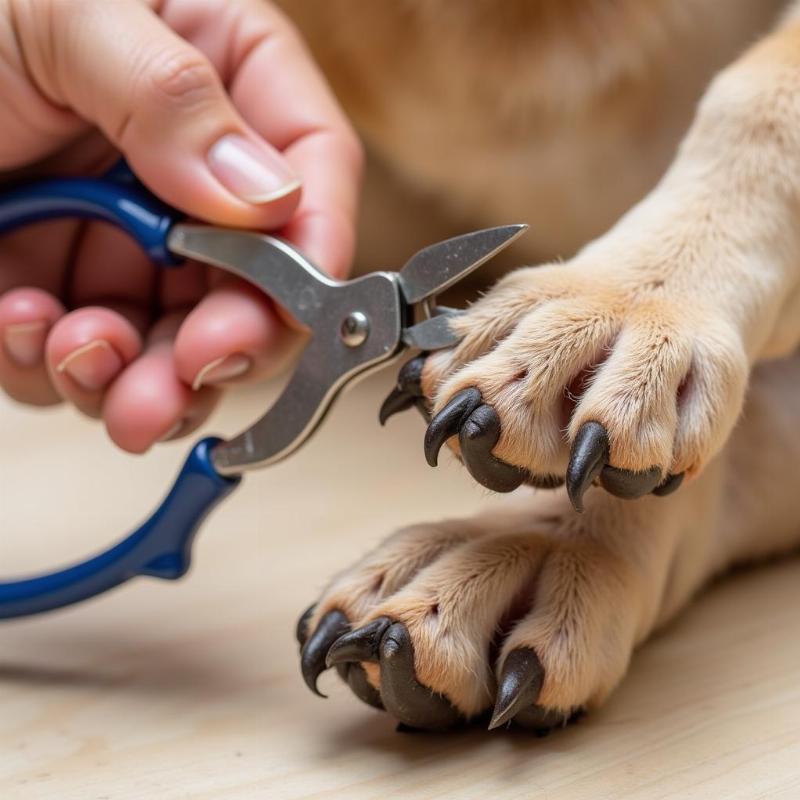Double dewclaws, those extra toes higher up on a dog’s leg, are a fascinating trait. While many dog owners are familiar with single dewclaws, the presence of double dewclaws raises questions about breed, genetics, and care. So, what dogs have double dewclaws? Let’s delve into this unique characteristic.
Breeds Predisposed to Double Dewclaws
Double dewclaws are most commonly associated with certain breeds, particularly those historically used for herding, guarding, or working in mountainous terrain. The Great Pyrenees, Beauceron, and Briard are prime examples. These breeds often utilize their dewclaws for added stability and grip, especially when navigating uneven or slippery surfaces. Other breeds known for double dewclaws include the Icelandic Sheepdog and the Estrela Mountain Dog.
While these breeds are predisposed to double dewclaws, it’s important to note that not every individual within these breeds will have them. The presence of double dewclaws is determined by genetics, and even within a litter, some puppies may have single, double, or even no dewclaws at all.
The Role of Genetics and Breed Standards
The presence of double dewclaws is governed by a specific gene. In breeds where double dewclaws are considered a breed standard, breeders often select for this trait. The American Kennel Club (AKC) recognizes double dewclaws as a standard feature in certain breeds, and their presence is considered desirable in show dogs. However, in other breeds, dewclaws, whether single or double, might be removed shortly after birth.
Caring for Double Dewclaws
Just like regular toes, double dewclaws require proper care. They can be prone to overgrowth, infection, and injury if not regularly trimmed and checked. Long nails on double dewclaws can curl back and grow into the paw pad, causing pain and discomfort. Regular grooming, including dewclaw trimming, is essential to maintain the dog’s overall health and well-being.
Are Double Dewclaws Beneficial or Detrimental?
While double dewclaws can provide added stability and grip, they can also be a source of potential problems. They can get caught on objects, leading to tearing or injury. In some cases, they may not be fully attached to the leg and can dangle loosely, increasing the risk of injury. For these reasons, some owners opt to have their dog’s dewclaws removed, especially if the dog is not working in an environment where they would be beneficial.
 Caring for a dog's double dewclaws
Caring for a dog's double dewclaws
Do All Herding Dogs Have Double Dewclaws?
No, not all herding dogs have double dewclaws. While common in some breeds like the Great Pyrenees and Briard, many herding breeds, such as the Border Collie and Australian Shepherd, do not typically have double dewclaws.
Conclusion
Double dewclaws are a unique characteristic found in specific dog breeds, often those with a history of working in challenging terrains. While they can offer advantages in terms of stability, they also require careful maintenance and monitoring to prevent potential problems. Understanding the genetics, breed standards, and care requirements associated with double dewclaws is crucial for any owner of a breed predisposed to this trait.
FAQ
- Are double dewclaws painful? Double dewclaws themselves are not inherently painful, but if the nails become overgrown or the dewclaw is injured, it can cause significant pain and discomfort.
- Should I have my dog’s double dewclaws removed? This is a decision best made in consultation with a veterinarian, considering the dog’s breed, lifestyle, and individual circumstances.
- How often should I trim my dog’s double dewclaws? Just like regular nails, double dewclaws should be trimmed as needed, typically every few weeks.
- Can double dewclaws be removed in adult dogs? Yes, although it is a more complex procedure in adult dogs than in puppies.
- Are double dewclaws a sign of a purebred dog? While double dewclaws are associated with certain purebreds, their presence alone does not guarantee a dog’s purebred status.
- Do double dewclaws affect a dog’s gait? In most cases, double dewclaws do not significantly affect a dog’s gait, unless they are injured or causing discomfort.
- Are there any health problems specifically associated with double dewclaws? No specific health problems are directly linked to double dewclaws, but they are susceptible to the same issues as regular toes, such as infections and injuries.
Related Articles on Beautdogs.us
Beautdogs.us is your premier source for all things dog-related in the United States. We provide expert advice on dog breeds, care, and products. Whether you’re a seasoned dog owner or just starting out, Beautdogs.us is your trusted resource for comprehensive and engaging information on canine companionship. For personalized advice or inquiries, reach out to us at [email protected] or call us at +1 501-555-7529.